Horse Dung Fungus
Hi Hive fungi lovers and mushroom hunters! Over the past few months, I've shared with you many of the edible mushrooms and fungi that can be found around sunny Gawler and the rest of South Australia.
It's still mushroom season but I'll shift my focus to other fungi that are or may not be edible. This post is about a useful, but inedible one, the Horse Dung Fungus (or 'Dog Shi&t' fungus as it is called in some places where the folks aren't as refined as here).
Phylum: Basidiomycota. Class: Agaricomycetes. Order: Boletales. Family: Sclerodermataceae.
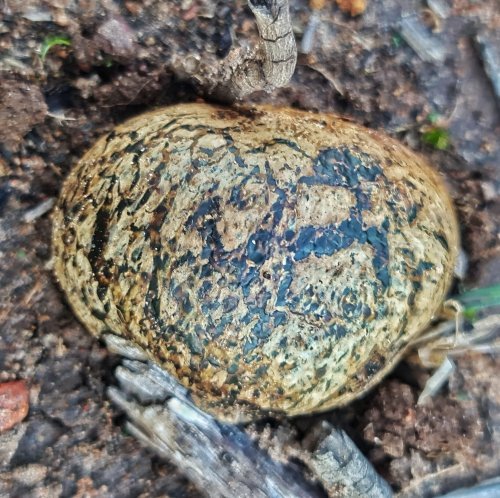
Inedible but far more useful, Pisolithus arrhizus is a very common fungus around Gawler and can often be found on the side of paths and roads. It’s common name, ‘Horse Dung Fungus’ comes from the look of the fungus as it sits by the side of paths, often in small groups, just like a pile of horse dung. The second, common name. ‘Dyeball’ comes from the fact that the viscous gel inside can be used to make a dye and it’s because of this that you’ll also see it listed as Pisolithus tinctorus.
It is pretty distinctive in its appearance. The outside of the body is smooth and shiny, with an irregular dark pattern. It dries and splits as it matures and eventually dries out to a dry mass of spores, drying from the top down. This process can take weeks and dries and powdery blobs of Pisolithus can be found on the side of paths for almost a month.
The inside of young specimens is shiny and black and has interesting patches of yellow/gold which are many separate compartments known as ‘pseudoperidioles’, within which the fungal spores develop.
As a dye –
Fresh – red-brown/black
Dry – golden brown
With Alum + iron as a mordant — chocolate brown
Pisolithus arrhizus is technically inedible, though you may see it listed as edible because, in Europe, small amounts are used to give food a truffle-like flavour, leading to another common name, “Bohemian Truffle”.
Pisolithus arrhizus forms associations with many plants and spores of it are used as part of an inoculant mix to help remediate degraded soil.
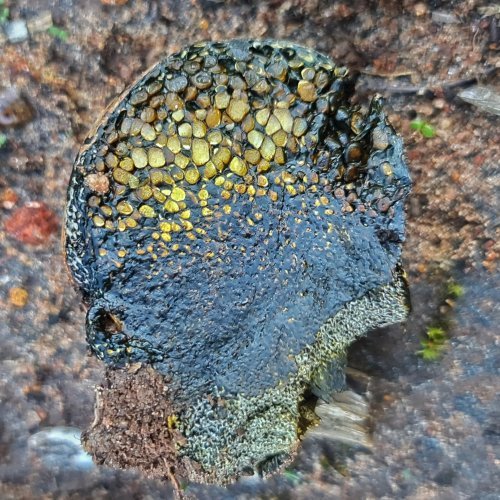
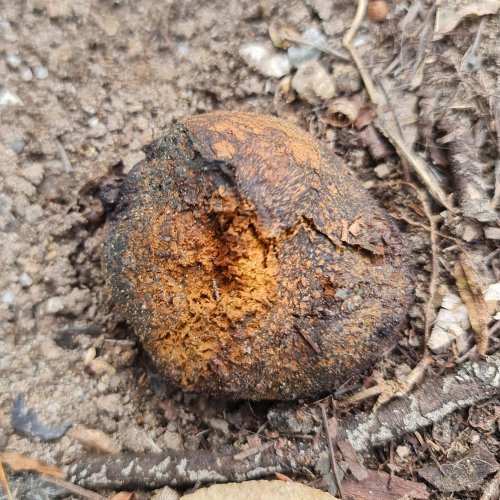
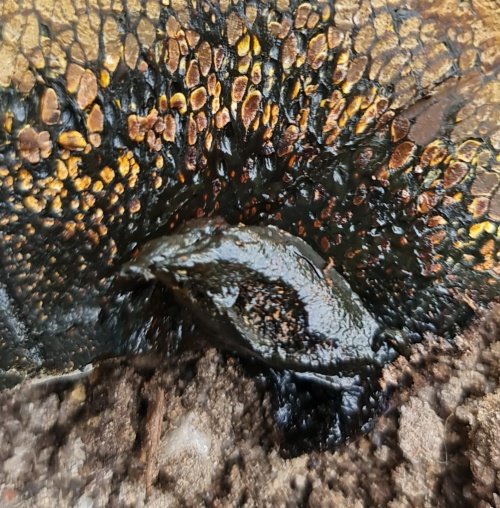
Identifying Horse Dung Fungus (Pisolithus arrhizus)- a summary
If you see something that looks like horse dung and it isn’t, look for these features –
- Dark, shiny skin with black mottling in young specimens
- Dry, split skin in older specimens, deteriorating to a brown mass of powdery spores that can remain for weeks
- Cut specimens show black flesh with yellow/gold pseudoperidioles
- A black goo forms inside
- Dyeballs can be found along parks and roads and can be found to burst through the surface of bitumen and gravel paths.
- No obvious mycorrhizae
- When mixed with water, the flesh makes a pink/brown dye.
- The fruiting body can stay around for weeks as it decomposes.
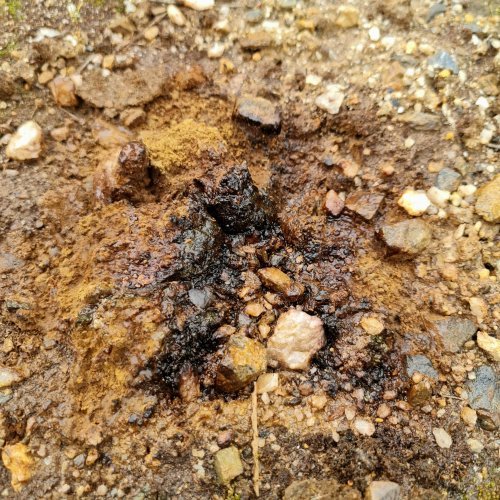








This is a unique mushroom, maybe I just saw it.
It's really not the most attractive, is it! Has Jelina used it as a dye with her work?
Hi! Nice post. BTW, how can we verify you own this site where this content was also posted?
https://ligayagarden.online/horse-dung-fungus-dyeball-pisolithus-arrhizus/
https://ligayagarden.online/horse-dung-fungus-dyeball-pisolithus-arrhizus/
So, how can we verify you own that site? I looked at it and saw references to Instagram and such, but not a reference to this blog on hive.
Why do I need that?
To verify you own the content and the reposting on Hive.blog is not plagiarism.
How's this referral link on our 'about us' page
https://ligayagarden.online/about-us/
That's excellent.
All good!
Very intresting (and useful -- for those who live in Australia) stuff. Thanks for sharing, the post is supported by FL community account and nominated for #OCD curation.
Thanks! I'm trying to raise awareness of Aussie fungi
Really cool fungus! I looked up the genus and apparently they occur near me which I didn't know (or at least the same genus). Dead's Man Foot is another name...huh. Thanks for sharing this, I'll be on the lookout for some near me :)
They're everywhere! Dead Man's Foot is another name but not commonly used here. Let us know if you discover any.
Thanks for your contribution to the STEMsocial community. Feel free to join us on discord to get to know the rest of us!
Please consider delegating to the @stemsocial account (85% of the curation rewards are returned).
You may also include @stemsocial as a beneficiary of the rewards of this post to get a stronger support.
No worries! Glad to be on board.
I can almost see the image of a horse in the first Horseshit fungus pic!
It definitely is an appropriate name!